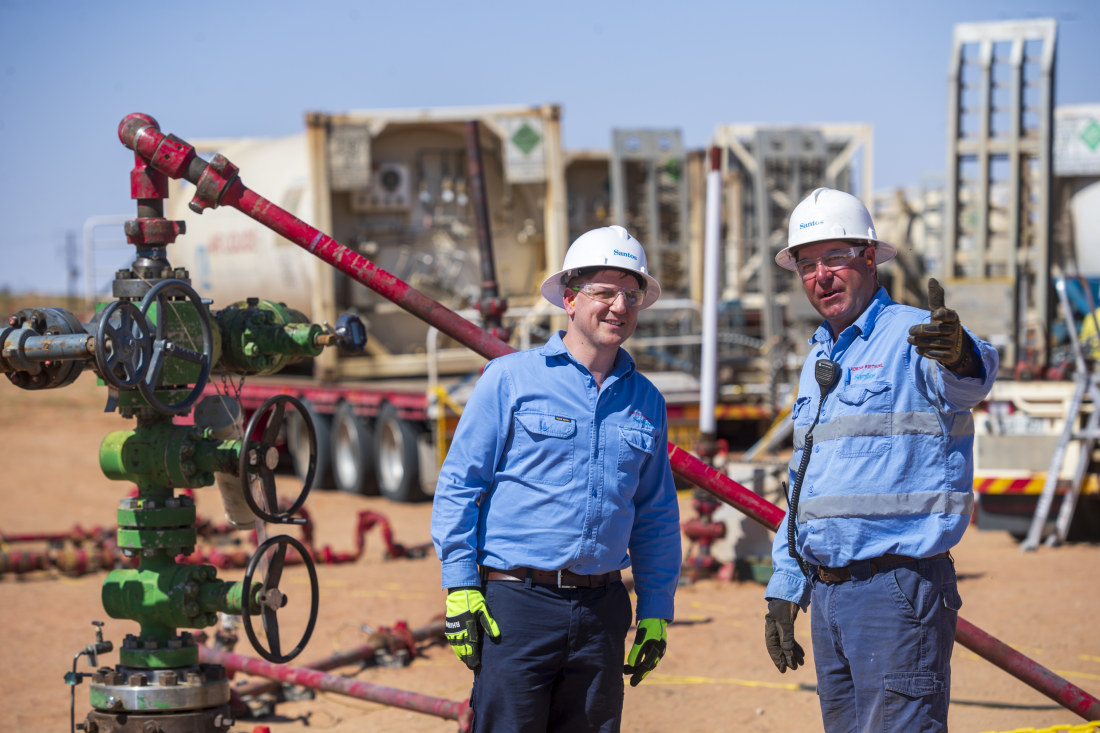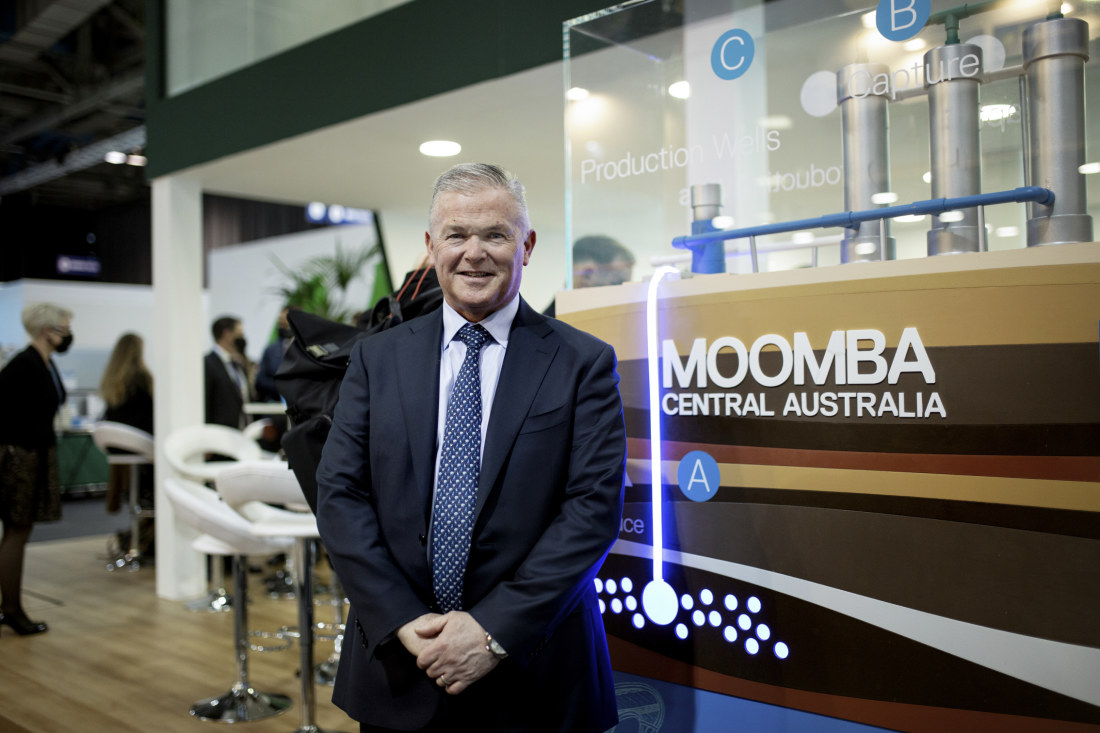Santos chief executive Kevin Gallagher says it’s disappointing that it’s taken this long, but now it’s nearing completion he won’t countenance failure.
“This technology will work, whether it’s at Cooper or anywhere else,” he says.
‘Threshold moment’
Moomba sits in the Cooper Basin, home to Australia’s most important onshore oil and gas fields. For decades Santos has been injecting gas into depleted wells there in the summer to store and sell in winter, and it understands the reservoirs and their “injectivity” very well, Gallagher says.
It doesn’t face the thorny challenges Chevron must overcome at Gorgon, injecting CO₂ into saline aquifers deep below the ocean bed.
Gallagher does concede a successful startup at Moomba CCS will bring a “threshold moment” for a technology which both the International Energy Agency and the Climate Change Authority say will be a vital part of the net-zero technology toolbox.
“Once this is up and running, it’ll be very difficult for anybody to say you can’t do this anymore,” he says.
For now, Gorgon CCS remains the only commercial CCS project operating in Australia. It managed to bury less than half its advertised 4 million tonnes a year in the year to July 17, 2022, and has had to buy carbon credits to cover six years of accumulated shortfalls. Critics doubt the integrity of carbon credits and dismiss them as lifelines for oil and gas.
Apart from Glencore’s CCS proposal at Queensland’s Millmerran coal power plant, most of the projects in development are at oil and gas sites. The only one at the front end engineering and design (FEED) stage is another Santos-led project – Bayu Undan – which aims to bury 10 million tonnes of CO₂ a year in the Timor Sea off Darwin from 2027.
Others include CarbonNet, a Victorian government project at the pre-FEED stage which aims to bury 5 million tonnes a year of CO₂ under Bass Strait on behalf of clients that include a widely panned hydrogen-from-brown coal venture for Japanese buyers, and Karratha CCS, a project of the Northwest Shelf partners which is in feasibility.
Also at the feasibility stage are ExxonMobil and Woodside Energy’s SEA CCS Hub (2 million tonnes a year under Bass Strait), and two projects in the Bonaparte basin off Darwin led by Santos and Inpex.
“If we’re going to get serious about net zero by 2050 – and Santos is trying to get there by 2040 – then all new greenfield projects should be abated,” Gallagher says. “Certain emissions are a hard to abate – you may need to get offsets. But primarily we should all want to strive to do that using CCS if that opportunity is available.”
Anne Forbes, research analyst at Wood Mackenzie, agrees new oil and gas projects – such as Woodside Energy’s Browse and Santos’ Barossa projects – will have to come with CCS.
She expects the safeguard mechanism’s new targets and “international best practice” requirement to jumpstart CCS projects. The requirement says any new gas fields developed to supply existing LNG plants must abate all emissions that come as a result of extraction, essentially forcing a net-zero rule from day one.
Wood Mackenzie expects the volume of CO₂ captured and buried in Australia to jump from a paltry 4 million tonnes a year now to more than 40 by 2034 – a material slice of the decarbonisation task. Australia currently emits around 488 million tonnes of carbon a year.
Steel and cement

Santos’ carbon capture storage project in South Australia. AFR
Oil and gas producers have faced most pressure to walk the walk on net zero, but heavy industry is intensifying its efforts.
BHP has six low carbon partnerships globally with steelmakers accounting for about 17 per cent of global steel production. Four involve either carbon capture, utilisation and storage (CCUS) – POSCO, China Baowu and ArcelorMittal – or CCS (Tata Steel). Two are hydrogen-direct iron reduction (DRI) projects, a process that does not require CCS (JFE Corporation and HBIS).
BHP is astutely placing its bets widely. It expects Asia’s young blast furnaces – the traditional primary steelmaking technology – to run for decades, and need CCS to mop up the copious emissions generated when iron ore is reduced to iron metal using coking coal.
In Europe many blast furnaces are nearing retirement, and pressure – and financial support – to skip straight to DRI using hydrogen produced from renewable energy is greatest. Still, BHP is building a CCS pilot at ArcelorMittal’s plant in Ghent, Belgium, which – if the economics work – will clear the way for a flagship European plant.
Australian cement makers are belatedly following suit. AdBri and Boral are discussing projects with Calix, an ASX-listed company operating a 25,000 tonne a year CCS pilot plant using its own technology at HeidelbergCement’s Lixhe, Belgium site, and building a 100,000 tonne a year plant in Hannover, Germany.
Calix’s Leilac process separates the CO₂ which is released when limestone is heated in a steel tube and captures it. Another project with UK cement giant Tarmac is at the FEED stage.
AdBri and Boral’s CCS journeys further illustrate CCS’s stop-start history in Australia. Calix began talking to them in 2020, as pressure to aim for net zero mounted. They received grants under the former coalition government’s CCUS fund ($11 million for AdBri, $30 million for Boral) around the time of the 2022 election. But these were cancelled with the entire fund after Labor came to office with a plan to refocus grants on heavy industry.
Calix chief executive Phil Hodgson says the company is working “minimally” on these pilots until funding becomes clearer. He hopes they will fall into one of the new funding buckets the Labor government is setting up for heavy industry because cement doesn’t have the zero-carbon options of steelmaking and metal processing.
The AdBri project has an extra feature – delivering 15,000 tonnes a year of captured CO₂ to the HyGATE project in South Australia to produce green methanol by combining CO2 and hydrogen.
The hydrogen would be made using clean energy from a solar thermal project for which Vast Solar has received $65 million of federal funding. Green methanol is a precursor for sustainable aviation and marine fuels, and HyGATE is a joint German-Australian hydrogen technology incubator.
Hodgson likes the idea of re-using the CO₂ rather than just injecting it straight into the ground, and even though it ends up in the atmosphere the process qualifies as emissions reduction under the European Union scheme.
Meanwhile construction continues in Hannover, helped by generous and predictable European Union incentives. If that succeeds it will pave the way for a full-scale cement plant CCS capable of capturing about 500,000 tonnes of CO₂, Hodgson says.
Net-zero pressure and measures such as the safeguard mechanism are bringing more inquiries from other industries such as aluminium, which is looking at the entire production chain from bauxite to final product.
Hodgson concedes technical risks will have to be overcome, but says billions of tonnes of industrial emissions that can’t be eliminated by substituting clean energy for fossil fuels still need to be dealt with.
Against those billions of tonnes, projects either operating or under construction in 2022 covered just over 50 million tonnes of CO₂, with just under 200 million tonnes more in development, the Global CCS Institute reports.
“We have to find a solution. And so the incentive sort of programs that are starting to drive interest in these areas are there because there’s that risk, but also that necessity,” he says.
One bugbear yet to be resolved is the time taken to permit CCS projects.
CO2CRC cheif executive Matthias Raab reckons it’s six to eight years – long enough to put completion of many current projects beyond 2030. That could become a knockout criteria for some projects that get overtaken by rapidly developing new zero-emissions technologies for steel, metal processing and chemicals, Raab says, so industry needs a pathway.
The Climate Change Authority, in its Reduce, remove, restore – The role of carbon sequestration in accelerating Australia’s decarbonisation report, lists other obstacles to deployment: a lack of standards; limited understanding of well-defined storage areas; and “moral hazard” – or the risk some industries will use CCS as an excuse to produce more.
For the latter problem, it recommends prioritising hard to abate sectors such as steel and cement.
Raab remains confident that CCS will be needed to accomplish a task as vast as net zeroing the world’s industries. But a much greater sense of urgency is required, he says.
Decarbonisation bet

Santos CEO Kevin Gallagher controversially showcased the Moomba CCS project at COP26 last year. Emily Macinnes
So does Gallagher. Moomba CCS is just phase one of Santos’ big bet on decarbonisation – its Energy Solutions division. The Moomba fields could eventually bury 20 million tonnes of CO₂ a year, drawn from coastal industries and even imports, he says.
Santos is also looking at making green hydrogen and trialling direct air capture (DAC) – absorbing CO₂ directly from the atmosphere – to make green methanol. If that can be made economically it could use existing pipelines and export facilities.
“We produce oil and gas, right – that’s what we do. And we emit carbon dioxide as a byproduct. It doesn’t matter to me whether you are a believer in climate change or a disbeliever in climate change, but the world wants less CO2 in the atmosphere,” Gallagher says.
“The world needs to decarbonise and we need to do it faster than we’ve been doing it. And so I’m very passionate about doing that and actually making real progress, not just talking about it, not greenwashing, getting the job done.
“The only way that the activists or the anti-CCS and the anti-fossil fuel mob propose is to shut everything down, right? And the world’s clearly not going to do that. So we want to get on with decarbonising and ultimately I believe that will be a great foundation for the move to cleaner fuels once we can make them work economically.
“But if we do nothing on decarbonisation right now, the world will simply go backwards. And companies like ours would not be able to reduce these emissions because if it’s not Santos – if you shut Santos down, if you shut Woodside down – they’ll just get the gas from the Middle East, or dare I say it from Russia, right?”
